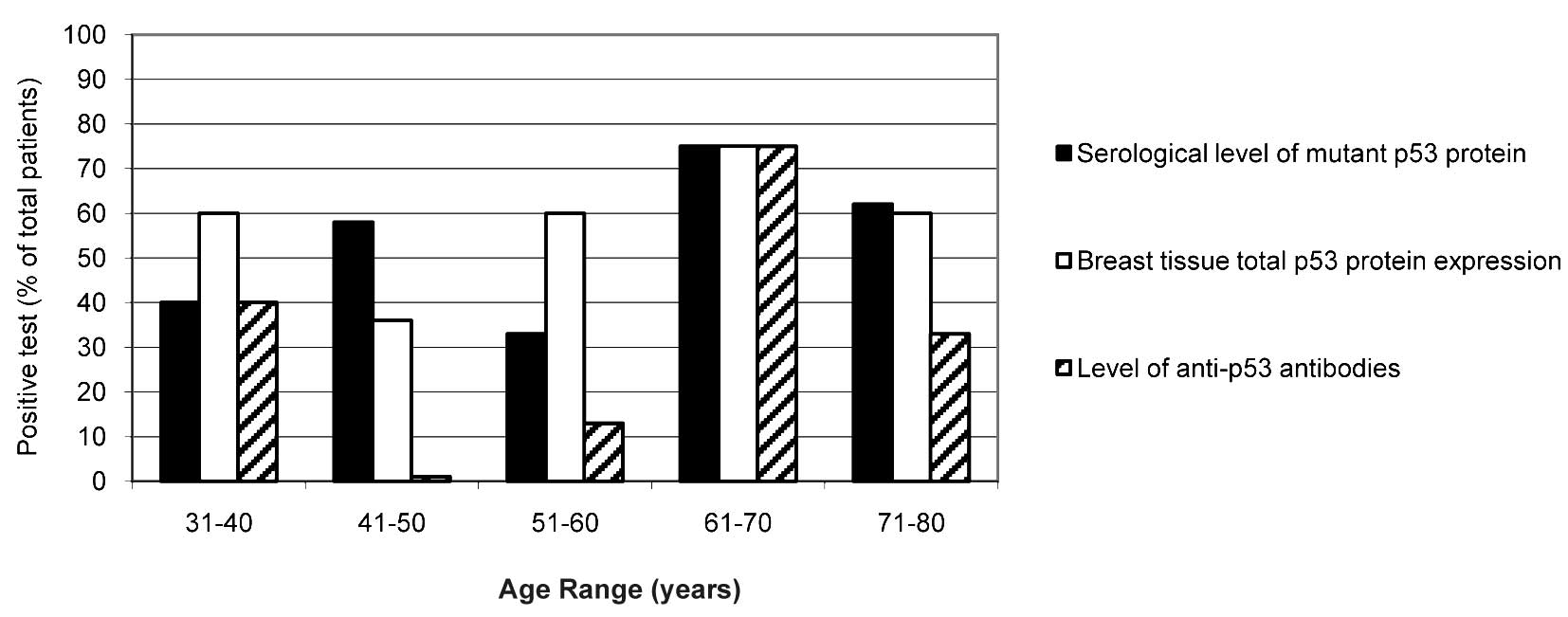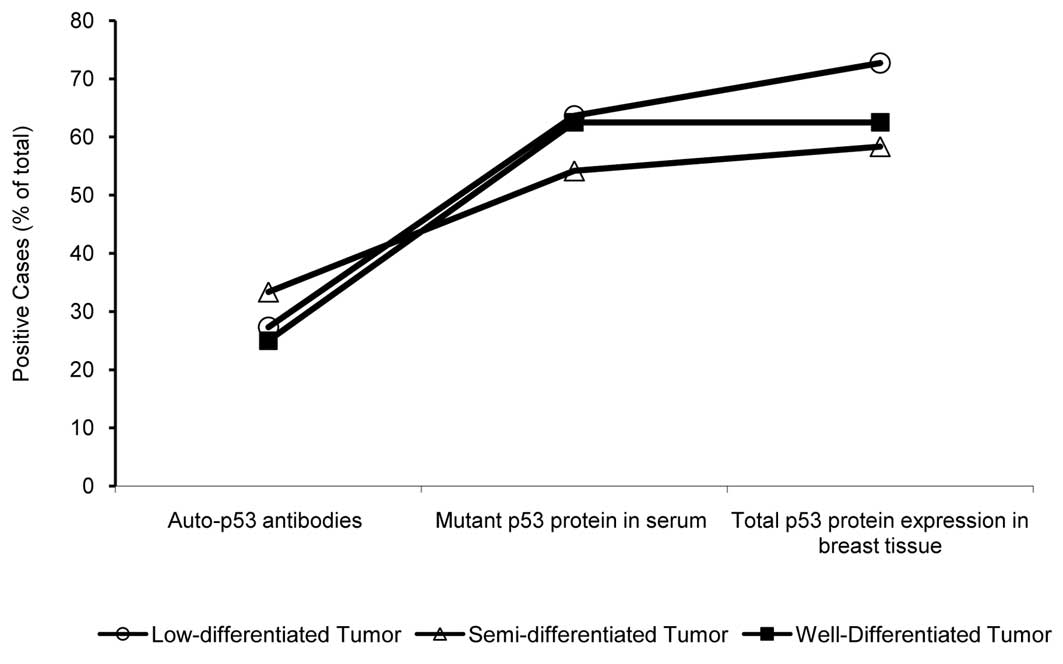|
1.
|
Ries L, Eisner M, Kosary C, et al: SEER.
Cancer Statistics Review. National Cancer Institute; Bethesda, MD:
pp. 1973–1999. 2002
|
|
2.
|
Greenie RT, Murray T, Boldin S and Wingo
P: Cancer statistics 2000. Cancer J Clin. 50:7–23. 2000. View Article : Google Scholar
|
|
3.
|
Stewart BW and Kleihues P: World Cancer
Report. IARC Press; France: 2003
|
|
4.
|
Oliveira AM, Ross JS and Fletcher JA:
Tumor suppressor genes in breast cancer: the gatekeepers and the
caretakers. Am J Clin Pathol. 124:S16–S28. 2005.PubMed/NCBI
|
|
5.
|
Bourdon JC, Laurenzi VD, Melino G and Lane
D: p53: 25 years of research and more questions to answer. Cell
Death Differ. 10:397–399. 2003.PubMed/NCBI
|
|
6.
|
Bourdon JC: p53 and its isoforms in
cancer. Br J Cancer. 97:277–282. 2007. View Article : Google Scholar : PubMed/NCBI
|
|
7.
|
Soussi T: The p53 pathway and human
cancer. Br J Surg. 92:1331–1332. 2005. View
Article : Google Scholar : PubMed/NCBI
|
|
8.
|
Casey G, Lopez ME, Ramos JC, Plummer SJ,
Arboleda MJ, Shaughnessy M, Karlan B and Slamon DJ: DNA sequence
analysis of exons 2 through 11 and immunohistochemical staining are
required to detect all known p53 alterations in human malignancies.
Oncogene. 13:1971–1981. 1997.PubMed/NCBI
|
|
9.
|
Dowell SP, Wilson PO, Derias NW, Lane DP
and Hall PA: Clinical utility of the immunocytochemical detection
of p53 protein in cytological specimens. Cancer Res. 54:2914–2918.
1994.PubMed/NCBI
|
|
10.
|
Crawford LV, Pim DC and Bulbrook RD:
Detection of antibodies against the cellular protein p53 in sera
from patients with breast cancer. Int J Cancer. 30:403–408. 1982.
View Article : Google Scholar : PubMed/NCBI
|
|
11.
|
Soussi T: Antibodies in the sera of
patients with various types of cancer: a review. Cancer Res.
60:1777–1788. 2000.PubMed/NCBI
|
|
12.
|
Vogl FD, Frey M, Kreienberg R and
Runnebaum IB: Autoimmunity against p53 predicts invasive cancer
with poor survival in patients with an ovarian mass. Br J Cancer.
83:1338–1343. 2000. View Article : Google Scholar : PubMed/NCBI
|
|
13.
|
Balogh GA, Corte MM, Nardi H, et al:
Mutant p53 protein in serum could be used as a molecular marker in
human breast cancer. Int J Oncol. 8:995–1002. 2006.PubMed/NCBI
|
|
14.
|
Lagios MD: Pathologic practice standards
for breast carcinoma: tumor size, reliable data, or miscues? J Am
Coll Surg. 196:91–92. 2003. View Article : Google Scholar : PubMed/NCBI
|
|
15.
|
Silverstein MJ and Lagios MD: Pathologic
findings from the National Surgical Adjuvant Breast Project (NSABP)
eight-year update of Protocol B-17. Cancer. 88:242–244. 2000.
|
|
16.
|
Soussi T: p53 antibodies in the sera of
patients with various types of cancer: a review. Cancer Res.
60:1777–1788. 2000.PubMed/NCBI
|
|
17.
|
Crawford LV, Pimand DC and Bulbrook RD:
Detection of antibodies against the cellular protein p53 in sera
from patients with breast cancer. Int J Cancer. 30:403–408. 1982.
View Article : Google Scholar : PubMed/NCBI
|
|
18.
|
Choi JH, Oh JY, Ryu SK, et al: Detection
of epidermal growth factor receptor in the serum of gastric
carcinoma patients. Cancer. 79:1879–1883. 1997. View Article : Google Scholar : PubMed/NCBI
|
|
19.
|
Oh MJ, Choi JH, Kim IH, et al: Detection
of epidermal growth factor receptor in the serum of patients with
cervical carcinoma. Clin Cancer Res. 6:4760–4763. 2000.PubMed/NCBI
|
|
20.
|
Sobti RC, Parashar K, Kaurand R and
Capalash N: Detection of human papillomavirus DNA, serum p53 and
p53 antibodies in patients with cervical cancer. J Environ Pathol
Toxicol Oncol. 21:79–85. 2002. View Article : Google Scholar : PubMed/NCBI
|
|
21.
|
Oh MJ, Choi JH, Lee YH, Lee JK, Hur JY,
Park YK, Lee KW, Chough SY and Saw HS: Mutant p53 protein in the
serum of patients with cervical carcinoma: correlation with the
level of serum epidermal growth factor receptor and prognostic
significance. Cancer Lett. 203:107–112. 2004. View Article : Google Scholar
|
|
22.
|
Micelli G, Donadeo A and Quaranta M: The
p53 tumor suppressor gene. A preliminary clinical study in breast
cancer patients. Cell Biophys. 21:25–31. 1992. View Article : Google Scholar : PubMed/NCBI
|
|
23.
|
Al-Moundhri M, Nirmala V, Al-Mawaly K,
Ganguly S, Burney I, Rizvi A and Grant C: Significance of p53,
Bcl-2 and HER-2/neu protein expression in Omani Arab females with
breast cancer. Pathol Oncol Res. 9:226–231. 2003. View Article : Google Scholar : PubMed/NCBI
|
|
24.
|
Labrecque S, Naor N, Thomson D and
Matlashewski G: Analysis of the anti-p53 antibody response in
cancer patients. Cancer Res. 53:3468–3471. 1993.PubMed/NCBI
|
|
25.
|
Trivers GE, Cawley HL, De Benedetti VM,
Hollstein M, Marion MJ, Bennett WP, Hoover ML, Prives CC, Tamburro
CC and Harris CC: Anti-p53 antibodies in sera of workers
occupationally exposed to vinyl chloride. J Natl Cancer Inst.
87:1400–1407. 1995. View Article : Google Scholar : PubMed/NCBI
|
|
26.
|
Gormally E, Vineis P, Matullo G, et al:
TP53 and KRAS2 mutations in plasma DNA of healthy subjects and
subsequent cancer occurrence: a prospective study. Cancer Res.
66:6871–6876. 2006. View Article : Google Scholar : PubMed/NCBI
|
|
27.
|
Mocci F and Nettuno M: Plasma mutant-p53
protein and anti-p53 antibody as a marker: an experience in vinyl
chloride workers in Italy. J Occup Environ Med. 48:158–164. 2006.
View Article : Google Scholar : PubMed/NCBI
|













